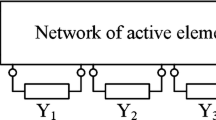Abstract
Fractional circuits have attracted the extensive attention of scholars and researchers all around the world in view of their superior performance and extra design freedom compared with conventional circuits. On the one hand, conventional circuit theory could be extended with the development of fractional circuits; on the other hand, the newly developed fractional circuits constitute a new challenge for the analysis and synthesis methods of conventional theory. As is known to all, almost no physical circuit can perform exactly in accordance with the design in view of the practical considerations such as the tolerance of circuit elements, environmental effects and aging problems. Therefore, the analysis of the effects of element parameter variations on circuit performance is of interest and should be considered during the design stage. Hence, it is necessary to conduct a sensitivity analysis for networks with fractional elements. In this paper, the adjoint network method is generalized to analyze the sensitivity of networks with fractional elements. The sensitivity formulae for the multi-port fractional elements are derived with the help of Tellegen’s theorem, and the time domain formulae are also derived. Some linear circuits and nonlinear circuits that contain nonlinear resistors are taken as examples to demonstrate the validity and accuracy of the formulae.














Similar content being viewed by others
References
M.S. Abdelouahab, R. Lozi, L. Chua, Memfractance: a mathematical paradigm for circuit elements with memory. Int. J. Bifurc. Chaos. 24(09), 1430,023 (2014)
S. Ahmed, A.G. Radwan, A.M. Soliman, Fractional-order mutual inductance: analysis and design. Int. J. Circ. Theor. Appl. 44(1), 85–97 (2015)
K. Biswas, L. Thomas, S. Chowdhury, B. Adhikari, S. Sen, Impedance behaviour of a microporous pmma-film coated constant phase element based chemical sensor. Int. J. Smart Sens. Intell. Syst. 1(4), 922–939 (2008)
D. Cafagna, Fractional calculus: a mathematical tool from the past for present engineers. IEEE Ind. Electron. Mag. 1(2), 35–40 (2007)
L. Chua, C.A. Desoer, E.S. Kuh, Linear and Nonlinear Circuits (Macgraw-Hill, New York, 1987)
C. Coopmans, I. Pet, Y. Chen, Analogue fractional-order generalized memristive devices, in ASME 2009 International Design Engineering Technical Conferences and Computers and Information in Engineering Conference (2009), pp. 1127–1136
S.W. Director, R.A. Rohrer, The generalized adjoint network and network sensitivities. IEEE Trans. Circuit Theory 16(3), 318–323 (1969)
M.E. Fouda, A.G. Radwan, Fractional-order memristor response under dc and periodic signals. Circuits Syst. Signal Process. 34(3), 961–970 (2015)
T.C. Haba, G. Ablart, T. Camps, F. Olivie, Influence of the electrical parameters on the input impedance of a fractal structure realised on silicon. Chaos Soliton Fract. 24(2), 479–490 (2005)
M. Nakagawa, Basic characteristics of a fractance device. IEICE Trans. Fundam. 75(12), 1814–1819 (1992)
K.B. Oldham, J. Spanier, The Fractional Calculus: Theory and Applications of Differentiation and Integration to Arbitrary Order (Dover Books on Mathematics, New York, 2006)
M. Ortigueira, An introduction to the fractional continuous-time linear systems: the 21st century systems. IEEE Circuits Syst. Mag. 8(3), 19–26 (2008)
I. Petras, Y.Q. Chen, Fractional-order circuit elements with memory, in Carpathian Control Conference (2012), pp. 552–558
I. Podlubny, I. Petras, B.M. Vinagre, P. O’Leary, L. Dorak, Analogue realizations of fractional-order controllers. Nonlinear Dyn. 29(1), 281–296 (2002)
A.G. Radwan, A.S. Elwakil, A.M. Soliman, Fractional-order sinusoidal oscillators: design procedure and practical examples. IEEE Trans. Circ. Syst. I 55(7), 2051–2063 (2008)
A.G. Radwan, M.E. Fouda, Optimization of fractional-order RLC filters. Circuits Syst. Signal Process. 32(5), 1–22 (2013)
A.G. Radwan, K.N. Salama, Passive and active elements using fractional \(\text{ l }_{\beta }\text{ c }_{\alpha }\) circuit. IEEE Trans. Circ. Syst. I 58(10), 2388–2397 (2011)
A.G. Radwan, K.N. Salama, Fractional-order RC and RL circuits. Circuits Syst. Signal Process. 31(6), 1901–1915 (2012)
A.G. Radwan, A.M. Soliman, A.S. Elwakil, First-order filters generalized to the fractional domain. J. Circuit Syst. Comput. 17(1), 55–66 (2008)
L.A. Said, S.M. Ismail, A.G. Radwan, A.H. Madian, M.F.A. El-Yazeed, A.M. Soliman, On the optimization of fractional order low-pass filters. Circuits Syst. Signal Process. 35(6), 2017–2039 (2016)
V.E. Tarasov, Review of some promising fractional physical models. Int. J. Mod. Phys. B 27(9), 187–205 (2015)
M.C. Tripathy, K. Biswas, S. Sen, A design example of a fractional-order Kerwin–Huelsman–Newcomb biquad filter with two fractional capacitors of different order. Circuits Syst. Signal Process. 32(4), 1523–1536 (2013)
Acknowledgements
This research was supported in part by the National Natural Science Foundation of China under Grant Nos. 51177048 and 51407073, the Natural Science Foundation of Hebei Province under Grant No. E2012502009, the Fundamental Research Funds for the Central Universities under Grant No. 11MG36, and the Fundamental Research Funds for the Hebei Province Universities under Grant No. Z2011220.
Author information
Authors and Affiliations
Corresponding author
Rights and permissions
About this article
Cite this article
Liang, G., Ma, L. Sensitivity Analysis of Networks with Fractional Elements. Circuits Syst Signal Process 36, 4227–4241 (2017). https://doi.org/10.1007/s00034-017-0504-y
Received:
Revised:
Accepted:
Published:
Issue Date:
DOI: https://doi.org/10.1007/s00034-017-0504-y




